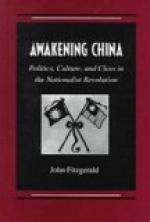The French, having colonies on the border, are naturally desirous of exploiting the provinces of this southern belt, and China is intensely suspicious of encroachment from that quarter.
[Page 54] CHAPTER XI
NORTHWESTERN PROVINCES
Shansi—Shensi—Earliest Known Home of the Chinese—Kansuh
Of the three northwestern provinces, the richest is Shansi. More favoured in climate and soil than the other members of the group, its population is more dense. Divided from Chihli by a range of hills, its whole surface is hilly, but not mountainous. The highlands give variety to its temperature—condensing the moisture and supplying water for irrigation. The valleys are extremely fertile, and of them it may be said in the words of Job, “As for the earth, out of it cometh bread: and underneath it is turned up as it were fire.” Not only do the fields yield fine crops of wheat and millet, but there are extensive coal measures of excellent quality. Iron ore also is found in great abundance. Mining enterprises have accordingly been carried on from ancient times, and they have now, with the advent of steam, acquired a fresh impetus. It follows, of course, that the province is prolific of bankers. Shansi bankers monopolise the business of finance in all the adjacent provinces.
Next on the west comes the province of Shensi, from shen, a “strait or pass” (not shan a “hill"), and si, “west.”
[Page 55] Here was the earliest home of the Chinese race of which there is any record. On the Yellow River, which here forms the boundary of two provinces, stands the city of Si-ngan where the Chou dynasty set up its throne in the twelfth century B. C. Since that date many dynasties have made it the seat of empire. Their palaces have disappeared; but most of them have left monumental inscriptions from which a connected history might be extracted. To us the most interesting monument is a stone, erected about 800 A. D. to commemorate the introduction of Christianity by some Nestorian missionaries from western Asia.
The province of Kansuh is comparatively barren. Its boundaries extend far out into regions peopled by Mongol tribes; and the neighbourhood of great deserts gives it an arid climate unfavourable to agriculture. Many of its inhabitants are immigrants from Central Asia and profess the Mohammedan faith. It is almost surrounded by the Yellow River, like a picture set in a gilded frame, reminding one of that river of paradise which “encompasseth the whole land of Havilah where there is gold.” Whether there is gold in Kansuh we have yet to learn; but no doubt some grains of the precious metal might be picked up amongst its shifting sands.
[Page 56] CHAPTER XII
OUTLYING TERRITORIES
Manchuria—Mongolia—Turkestan—Tibet, the Roof of the World—Journey of Huc and Gabet.




